Sulfonic acids are produced through the sulfonation process. Sulfur trioxide is usually the sulfonating agent. The wide application of this method is the production of alkylbenzene sulfonic acids. Sulphonic acids are strong acids. They are usually listed as one million times stronger than the corresponding carboxylic acid. For example, p-Toluenesulfonic acid and methanesulfonic acid have pKa values of -2.8 and -1.9, respectively, while those of benzoic acid and acetic acid are 4.20 and 4.76, respectively. However, as a result of their strong acidity, their pKa values cannot be measured directly, and the commonly quoted values must be considered as indirect estimates with considerable uncertainty. For example, various sources have reported the pKa of methanesulfonic acid as high as -0.6 or as low as -6.5. Sulfonic acids react with solid sodium chloride (salt) to form sodium sulfonate and hydrogen chloride. This property indicates an acidity two or three times that of HCl(g), whose pKa has recently been accurately determined (pKaaq = -5.9).


